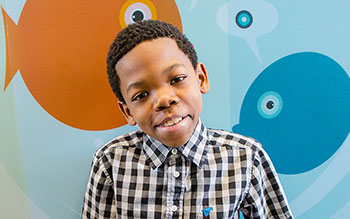Miracle Kid: Gary Burks
Boy Inspires Others by Overcoming a Stroke, Sickle Cell Anemia
 Latonya Burks can’t suppress her smile when she talks about her son, Gary, an 11-year-old sports fanatic who has always been a source of happiness for people around him. His beaming smile and positive spirit rub off on anyone he meets.
Latonya Burks can’t suppress her smile when she talks about her son, Gary, an 11-year-old sports fanatic who has always been a source of happiness for people around him. His beaming smile and positive spirit rub off on anyone he meets.
“He lives with the mindset that whatever he is going through, someone else is going through something worse,” Latonya said.
That hasn’t always been the case, though. All his life, Gary has been living with the pain and complications of sickle cell disease, a serious and lifelong disorder that causes the body to make sickle-shaped red blood cells, which are stiff and sticky. Blood flow in the blood vessels can become blocked anywhere in the body, causing pain, infection, and organ damage.
Latonya, a Rochester resident, knew during her pregnancy that Gary would have sickle cell anemia, which occurs in about one out of every 600 African-American births. Latonya’s mother told her at a young age that she was a carrier of the sickle cell trait, but she didn’t realize the disease could be potentially deadly if two people with the same trait conceived a child.
 The effects of sickle cell disease can vary greatly from person to person. Gary was hospitalized numerous times between birth and age 4 with upper respiratory issues, acute chest syndrome that often came with a fever, excruciating pain crises, shortness of breath, and low oxygen levels.
The effects of sickle cell disease can vary greatly from person to person. Gary was hospitalized numerous times between birth and age 4 with upper respiratory issues, acute chest syndrome that often came with a fever, excruciating pain crises, shortness of breath, and low oxygen levels.
“I remember the first time he had a crisis. He was almost 2 years old. His hands and feet were a reddish tone, swollen, and he was in a tremendous amount of pain,” said Latonya. “That didn’t stop him from scooting all over the hospital trying to play with the nurses. He refused to sit still.”
When Gary was four, Latonya brought him into his pediatrician with cold-like symptoms. It wasn’t until they were sitting in the waiting room that Latonya noticed that her ever-energetic son was sitting slumped, quiet, and withdrawn. Latonya thought it may have been yet another pain crisis of his body or acute chest syndrome.
After being admitted to the hospital and watching her son lay in bed, she noticed that he was drooling, which she had never seen before. It was only during his admission that he showed weakness on his right side, which caused half of his face to appear droopy. Doctors told Latonya her son had suffered a stroke. He was immediately transferred to the pediatric intensive care unit at Golisano Children’s Hospital for treatment.
“It was like time had stood still after I heard the word stroke,” said Latonya. “I felt like my thoughts were frozen. I was scared and did not know how this would impact his health or his life.”
“The first thing we had to do was to assess the damage,” said Laurie Johnson, a pediatric nurse practitioner who has been overseeing Gary’s care for the past seven years at Golisano Children’s Hospital. “Any child with sickle cell that has a stroke is immediately put on a routine transfusion program. The reason we put him on a transfusion regimen was to prevent him from having another stroke that could have potentially escalated to a deadly situation.”
 Strokes in children with sickle cell anemia are caused by the progressive narrowing of blood vessels which prevents oxygen from reaching the brain.
Strokes in children with sickle cell anemia are caused by the progressive narrowing of blood vessels which prevents oxygen from reaching the brain.
Monthly transfusions can help prevent stroke and other complications, but they were very difficult for Gary. Because of his small veins, he needed a central venous catheter placed in his chest to reduce the blocked blood flow caused by the sickle cells.
“By giving him un-sickled blood, we are preventing areas from getting clogged up by the sickled cells,” said Johnson.
After his stroke, Gary was tasked with relearning the basic tasks that had previously come so easily to him. He had to work with an occupational therapist to regain usage of his right hand, and has worn a brace on his right foot as a precaution to improve his stability since the stroke.
Gary also underwent tenotomy surgery after his stroke to improve the positioning of his right foot. Because the stroke impaired Gary’s growth, it forced his foot muscles to resist development, so his tenotomy surgery cut his tendon partway through, allowing his muscle to be stretched for future growth.
“The overall incidence for stroke in a child with sickle cell is low, occurring in just about 10 percent of children with the disease,” said Razia Ahktar, M.D., assistant professor of Pediatrics. “But when it does occur, it can result in long-term effects as seen with Gary.”
Ahktar now monitors Gary for iron deposits in his abdomen and liver, a result of transfusions. If iron accumulates in excess in either of these places, it could cause heart problems. Gary undergoes yearly MRI's to monitor his iron level along with numerous other tests that monitor his brain, heart, and lungs to prevent stroke and other health issues.
“Gary has faced morbidity and mortality at far too young an age,” said Ahktar. “He has been so poised dealing with his disease throughout his childhood; he’s such a pleasure to be around.” Ahktar also added that Gary doesn’t let his disease hold him back from competing with his friends in athletic activities
 Latonya said that Gary sometimes gets frustrated answering questions about why he walks with a limp, or what is wrong with his arm. “He doesn't want to explain to children what happened to him or why he walks the way he walks,” Latonya said. “I remind him of all of his accomplishments and that he can be a help to others.”
Latonya said that Gary sometimes gets frustrated answering questions about why he walks with a limp, or what is wrong with his arm. “He doesn't want to explain to children what happened to him or why he walks the way he walks,” Latonya said. “I remind him of all of his accomplishments and that he can be a help to others.”
“I am amazed at how far Gary has come since I’ve met him,” said Johnson. “His smile always brightens my day.”
Gary is currently doing what he does best, making people smile and laugh. When asked about his experience at Golisano Children’s Hospital, Gary was quick to point out his favorite thing about coming to get treatment: "I love all the doctors and nurses that take care of me when I come to the hospital. I especially love when the girl nurses take care of me,” he joked.
Gary will continue to receive monthly exchange transfusions and yearly MRIs to monitor his iron levels. With much prayer, patience, and practice, Gary’s been able to adapt to life after having a stroke, and now primarily uses his left hand for throwing, catching, and writing. His huge imagination allows him to accomplish more than anyone ever dreamed he’d be able to.